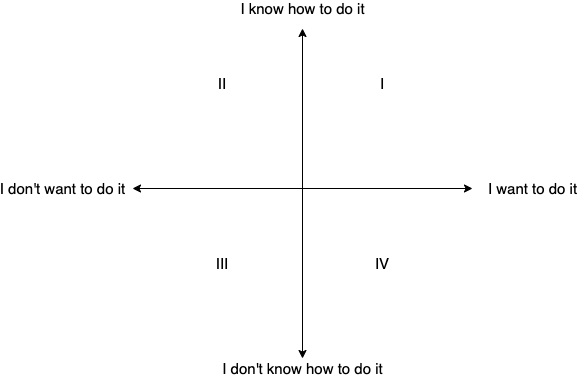What motivates me to write or practice a piece? As I grow older with less time and energy, I must strategize what to do for the next research or creative activity. The decision-making process is multidimensional, but a simplified guideline helps me. I ask two questions before I commit to a project.
- Do I want to do it?
- Do I know how to do it?
Answers to these two questions yield four degrees of motivation plotted as four quadrants in a graph. My goal is to identify in which quadrant I start the project so that I can identify the level of motivation and amount of work. I also find that the answers to the above questions change at the end of the project, sometimes.

I am most eager to work on a project that starts in Quadrant IV and ends in Quadrant I. Changing the “I don’t know” axis to the “I know” axis takes time and energy, but that process is what being a researcher, artist, and student is all about. Learning SuperCollider was an IV-I move. Going to graduate school to be a teacher was IV-I. Improvising on a no-input mixer was IV-I. Spending a few months of the COVID quarantine time to learn Mark Applebaum’s Aphasia was IV-I.
Quadrant IV is also a fandom area. While some pieces move from VI to I, like Aphasia or Alvin Lucier’s Music on a Long Thin Wire, I don’t mind Jeff Mills’ Exhibitionist Mix 3 and Bach’s music staying in Quadrant IV. Discovering and admiring awe-inspiring pieces is what being a researcher, artist, and student is all about. The permanent Quadrant IV pieces become motivations for new pieces as well. Cobalt Vase is my homage to Exhibitionist, and 847 Twins is my Bach fan art.
Ideally, all projects should end up being in Quadrant I, where I am happy to do the work with the skills I know. Realistically, many works fall into quadrants II and III. Dismissing them is not always possible, especially when the projects involve benefits like money, graduation, future opportunities, etc. Some projects in Quadrant III move into Quadrant I through education and repeated experience. Many dance and sound installations were my III-I projects because I learned more about the benefits of collaboration as I got more experience and studied more. Witnessing students doing the III-I move is equally exciting as students doing the IV-I move in my music technology classes.
In contrast to the III-I or IV-I move, II-I moves are much rarer. Projects in Quadrant II often stay in Quadrant II, and they involve extra motivational factors, like deadlines or funding, to accept and finish the project. Some projects move from Quadrant I to II due to burnout or changed interest. Such regression, however, was not always bad, as it pointed me to new artistic/aesthetic directions. I am currently not focusing on further developing free improvisation skills as I feel the plateau or burnout. This condition led me to make notated electronic music less dependent on an individual’s improvisation skills. My notated electronic pieces gain more performance opportunities nowdays, and I am happy to present both improvisational and no-improvisational pieces in a show. Music career is cumulative.
Evaluating the need to start a project by asking two simple questions with four possible answers clarified my thoughts. Perhaps I could extend this to plot listener reactions. I want the audience, colleagues, or commissioners to feel Quadrant I when they listen to my piece (I want to play it, and I think I figured out the technology!). The audience feeling Quadrant IV could be good (I don’t know how he’s making that sound, but I want to try!), especially if they are scholars or performers. Learning opportunities and capable institutions abound for the audience in Quadrant IV. I hope my pieces do not fall into Quadrants II and III.
